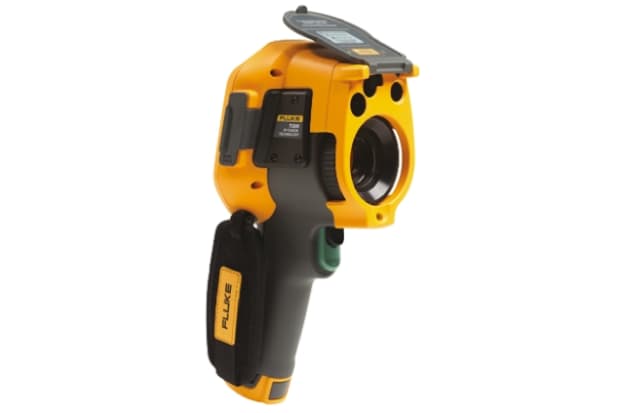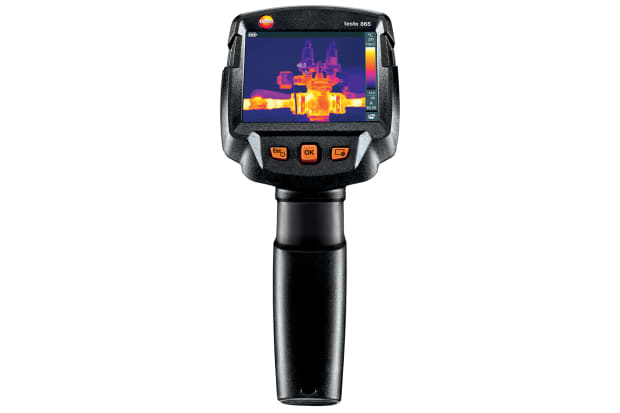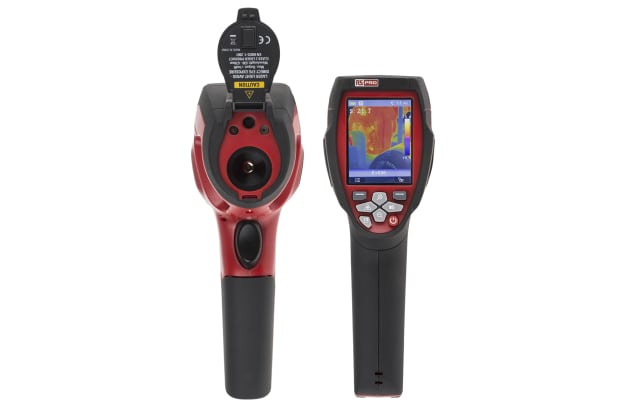- Published May 13, 2024
- Last Modified May 13, 2024
- 13 min
Everything You Need To Know About Thermal Imaging Cameras

What are thermal imaging cameras?
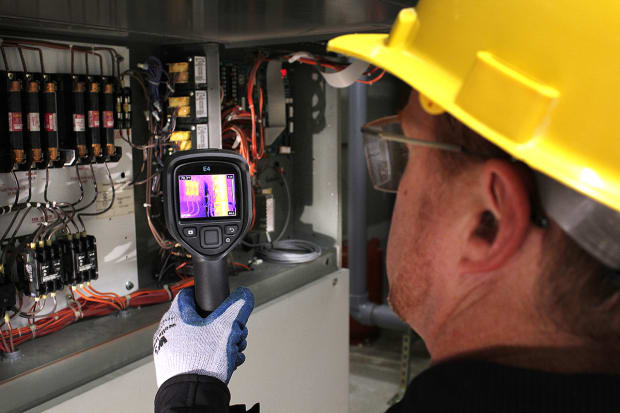
Thermal imaging cameras are handheld electronic devices with an integrated visual display, designed for detecting heat energy.
The key component of a thermal camera is a heat sensor attached to a special type of lens, which is then adapted to work alongside standard image-capture technologies. This allows engineers to quickly identify regions of excessive temperature or sources of wasted heat energy, such as overheating components or potential thermal insulation gaps in building inspection.
Visible light forms only a small part of the electromagnetic spectrum, and the only part we can actually see. When pointed at an object or area, the sensor on a thermal detection camera allows the user to view the otherwise invisible infrared spectrum, which exists at wavelengths between visible light and microwaves.
This is often rendered as a colour map in modern IR cameras, although black-and-white displays are still preferred for certain applications due to their reduced visual ‘busyness’ and improved capture of fine detail.
On a colour thermographic display, warmer components or regions will show up as reds, oranges and yellows, while cooler parts will typically be shown as purples and blues (green usually indicates areas that are roughly at room temperature). Because they measure infrared radiation, and not visible light, thermal cameras are also useful for identifying heat sources in very dark or otherwise obscured environments.
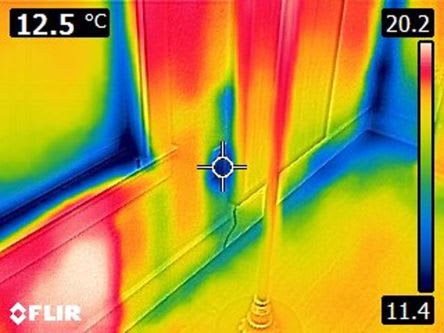
Quality thermal imaging cameras are often sold in a selection of user-friendly ergonomic designs and offer temperature detection capabilities spanning a broad range of heat sensitivities. This makes them a valuable companion to emergency response units, medics, product manufacturers, engineers and maintenance workers across a wide variety of industries - as well as an increasingly affordable option for many different types of hobbyists and enthusiasts at home.
The history of thermal imaging cameras
It’s only in the past few years that the mass production of thermal imaging technologies has reached a point where handheld thermographic cameras (also known as heat cameras, thermal detection or infrared cameras) are now an accessible option for most civil applications and/or hobbyist use.
However, viewing heat energy as an infrared spectrum display isn’t actually a new concept by any means; in fact, the roots of the basic thermography principle were established more than 200 years ago by the German-British astronomer William Herschel:
- In simplified terms, Herschel was the first to discover the presence of infrared, all the way back in February 1800, while using a prism to study the visible light spectrum
- Herschel found he could place a thermometer just beyond the red light end of the spectrum to detect the existence of a hitherto unknown invisible band, warmer than any of those in visible light
- Today, we refer to this invisible band as ‘infrared’ radiation, which lies between visible light and microwave frequencies on the electromagnetic spectrum

Although thermal imaging camcorders were still a long way off, Herschel’s findings were quickly used to produce a number of early thermocouple-type modules, which could detect the unseen heat emanating from warm bodies at a considerable distance. His initial discovery was further developed by many other physicists, engineers and inventors in subsequent years:
- Especially important to the development of the thermal imaging technologies we use today was the work of Hungarian polymath Kálmán Tihanyi (also responsible for pioneering cathode ray TV technology)
- In 1929, Tihanyi effectively created the first ‘night vision’ infrared video cameras for use in British anti-aircraft defences
- During the 1970s, the technology rapidly moved towards solid-state thermal-imaging arrays, and eventually on to modern hybridised single-crystal-slice imaging devices
- Handled units developed through the 1980s and 1990s were far more versatile, user-friendly, and didn’t require active cooling to work, unlike early mechanical versions
- Still, thermal imaging cameras didn’t really become a financially viable option for most civil uses until the early 2000s, which saw dramatic reductions in the production costs of uncooled arrays
- This led to a boom in the popularity of heat camera use for applications such as emergency response, architecture analysis, medical diagnostics, environmental control and autopiloting systems.
Today, the plummeting cost of cutting-edge technologies like smart sensors, microcircuitry and WiFi connectivity make thermal video cameras a popular addition to many professional and household engineering, repair, design, creative and hobbyist toolkits.
How thermal imaging cameras work?
An infrared, IR or thermal imaging camera works by detecting and measuring the infrared radiation emanating from objects - in other words, their heat signature.
In order to do so, the camera must first be fitted with a lens that allows IR frequencies to pass through, focusing them on to a special sensor array which can, in turn, detect and read them.
The sensor array is constructed as a grid of pixels, each of which reacts to the infrared wavelengths hitting it by converting them into an electronic signal. Those signals are then sent to a processor within the main body of the camera, which converts them using algorithms into a colour map of different temperature values. It’s this map which is sent on to be rendered by the display screen.
Many types of thermal imaging camera will also include a standard shooting mode that works with the visible light spectrum, much like any other point-and-click digital camera. This allows for easy comparison of two identical shots - one in IR and one in normal mode - to help quickly identify specific problem areas once the user steps out from behind the lens.

Uses of thermal imaging cameras
Beyond basic engineering applications, the emergency services are among the more familiar users of thermal detection cameras today. The technology is deployed regularly in scenarios including firefighting, night-time police pursuits, and disaster response search and rescue.
However, there are a number of other widespread uses of thermal imaging cameras today that may be less obvious. In this section, we’ll look briefly at some of the more common scenarios.
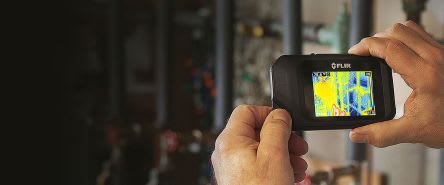
Thermal cameras for drones
Thermal imaging is often used in remotely piloted drones (UAVs), greatly enhancing general recon capabilities in dangerous or difficult-to-observe conditions. In hobbyist drones, thermal imaging can be a great asset to photographers for a wide range of purposes, while UAV thermal imaging is also highly beneficial to emergency response units, search and rescue teams, and in tactical military applications
Thermal imaging cameras for fire detection
Thermal imaging not only helps firefighters to locate survivors in low-visibility conditions where dust, fog, ash and other contaminants occlude visibility - it can also help detect hotspots, further potential sources of ignition, or indicate the presence of still-burning fires which may be originating from unexpected locations (such as underground or within cavity walls, for example).
Thermal imaging cameras for Apple & Android devices
There is a plethora of ‘thermal’ and ‘infrared’ photo apps available for Apple iOS and Android phones these days. However, they’re pretty much all just simulations; standalone apps don’t really do much besides putting a fancy filter on your phone camera, effectively mimicking the overall look of thermal detection imaging.
For a real experience of thermal imaging on a smartphone, you’ll need to buy an auxiliary thermal camera device that can be attached to the handset and used in conjunction with a dedicated app for the hardware.
They’re not cheap by most mobile accessory standards - but until iPhones start shipping with a dedicated true IR camera, these third-party add-ons are currently the only way to perform genuine heat detection with a smartphone.
Thermal imaging cameras for wildlife
Wildlife photography, animal tracking and environmental monitoring are all common uses of thermal imaging technology today. IR cameras equipped with smart sensors can be set up and left unmanned in natural habitats, triggering automatically in the presence of nocturnal or otherwise hard-to-spot wildlife. This enables far more comprehensive monitoring of species and behaviours in some regions than has previously been possible.
In addition, enthusiast spotters and trackers frequently rely on thermal detection to help locate warm-blooded animals in poor visibility, to bypass visual camouflage conditions, or to remain aware of non-targets in hunting or development areas which may otherwise be at risk of harm.
Thermal imaging marine cameras
There are some very important marine applications of thermal imaging, not least as a significant boost to collision detection systems when sailing at night, in fog, or during severe weather. While underwater thermal imaging per se is rather limited in its effectiveness (even with the most advanced technologies) as previously discussed, it’s not unusual today to find heat detection cameras manufactured to marine grade specifications and mounted in multiple positions aboard seagoing vessels of all sizes.
Thermal security cameras
Almost all business premises today deploy security camera technologies in one form or another. In recent years, it has become increasingly standard practice to rely on thermal imaging surveillance equipment for the best possible results in terms of protection, identification and return on investment.
Thermal security cameras reliably perform very well in low light and poor visibility areas, as well as providing the ability to strip away much of the visual camouflage - such as dense foliage - that’s often found close to offices and warehousing. In addition, thermal imaging CCTV cameras are usually bundled with smart sensors and advanced analytics technology, helping to reduce the number of false alarms.
Finally, heat detection-based systems are often cheaper to install and run long-term than standard CCTV setups, which need to be placed along every available line of sight in order to be fully effective - and which frequently require costly additional lighting to be rigged nearby in order to provide even basic functionality.
Night vision cameras
Although both thermal imaging IR cameras and standard ‘night vision’ units can be used to increase visibility in low light or otherwise occluded conditions, they’re actually two distinct products that rely on different technologies.
The key difference is that night vision cameras, of the type seen in dozens of films (usually characterised by a grainy green-and-white night-time display), rely on there being just the right amount of ambient light present to amplify what little it detects. For obvious reasons, the sensor can’t cope with too much light - but many people don’t realise that in a completely dark environment, night vision technologies can’t outperform a human eye either.
Many night vision cameras are therefore equipped with an additional infrared illumination function, in order to provide a greater wavelength of amplifiable electromagnetic signals to help the sensor out in very murky conditions. These are invisible to the naked eye but can easily be detected by anyone else using night vision; not a problem in many applications, but far from ideal in many militaries or surveillance uses.
While night vision often provides a more naturalistic image in the right conditions, it’s also significantly less effective than thermal imaging in revealing targets obscured by fog, smoke, dust or camouflage.
Industrial infrared cameras
Many current thermal imaging cameras are certified specifically for industrial use, with various different configurations and manufacturing standards available on the market to suit a range of particularly challenging applications and environments.
Examples include cameras certified for use in areas subject to explosive gasses (e.g. the petrochemical industry); in below-ground applications such as mining; or around high volumes of airborne dust particles found in industries like sugar production and grain-handling.
If you’re likely to need a specific certification for your industrial infrared camera use, always check with suppliers and consult manufacturing guidelines to confirm that all relevant standards - such as ATEX and IECEx approval for safe use in Zone 1 explosive atmospheres - have been met.
FAQs about thermal imaging camera usage
Alongside frequently asked questions about how thermal imaging cameras work in general, there are also a number of common queries regarding specific use scenarios and the effectiveness of the technology in particular environments or applications.
In this section, we’ll examine a few of the better answers and the reasoning behind them.
Summary
With so many varieties, designs and sensitivities of thermal imaging cameras available, it’s important to know exactly what it is you’re shopping for before deciding on a specific product or accessories. Key considerations that will influence your ideal purchase include:
- Price
- Brand
- Certification
- Size and weight
- Ergonomics and design
- Image resolution
- Thermal range
- Lens interchangeability
- Calibration
For more information on any particular heat detection products, or for further advice and assistance with thermal imaging cameras in general, feel free to contact a member of our expert support team by phone, email or live web chat.
Related links
- Flir Thermal Imaging Cameras
- Thermal Imaging Cameras
- FLIR Charge Base for Use with E4 E6, E8 Thermal Imaging Cameras
- Fluke Thermal Cameras
- Fluke Thermal Imaging Camera Thermal Imager Visor
- Fluke Thermal Imaging Camera Thermal Imager Visor for Use with Ti200 Ti400
- Fluke Thermal Imaging Camera Accessories
- Fluke TI300U Thermal Imaging Camera 384 x 288pixel Detector Resolution

